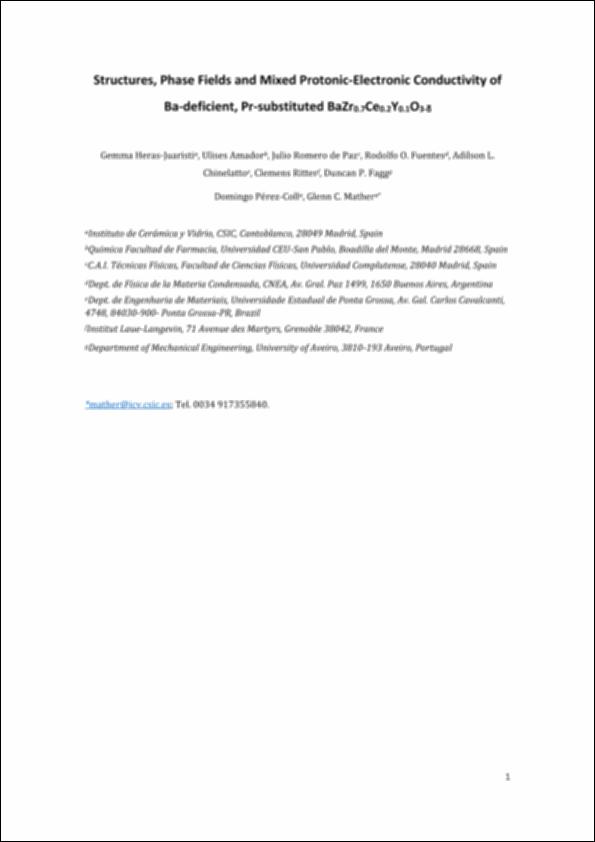Please use this identifier to cite or link to this item:
http://hdl.handle.net/10637/14809Structures, Phase Fields, and Mixed Protonic–Electronic Conductivity of Ba-Deficient, Pr-Substituted BaZr0.7Ce0.2Y0.1O3−δ
| Title: | Structures, Phase Fields, and Mixed Protonic–Electronic Conductivity of Ba-Deficient, Pr-Substituted BaZr0.7Ce0.2Y0.1O3−δ |
| Authors : | Heras-Juaristi, Gemma Amador Elizondo, Ulises Julio Romero de Paz, J. Fuentes, Rodolfo O. Chinelatto, A. L. Ritter, Clemens Fagg, Duncan P. Pérez-Coll, Domingo Mather, Glenn C. |
| Keywords: | Atmospheric chemistry; Cations; Defects in solids; Electrical conductivity; Perovskites |
| Publisher: | American Chemical Society |
| Citation: | Gemma Heras-Juaristi, Ulises Amador, Julio Romero de Paz, Rodolfo O. Fuentes, Adilson L. Chinelatto, Clemens Ritter, Duncan P. Fagg, Domingo Pérez-Coll, and Glenn C. Mather, Structures, Phase Fields, and Mixed Protonic–Electronic Conductivity of Ba-Deficient, Pr-Substituted BaZr0.7Ce0.2Y0.1O3−δ, Inorganic Chemistry 2018 57 (23), 15023-15033, DOI: 10.1021/acs.inorgchem.8b02956 |
| Abstract: | The BaZr0.7Ce0.2Y0.1O3−δ–BaPrO3−δ perovskite system, of interest for high-temperature electrochemical applications involving mixed protonic–electronic conductivity, forms a solid-solution with a wide interval of Ba substoichiometry in the range Ba(Ce0.2Zr0.7)1–xPrxY0.1O3−δ, 0 ≤ x ≤ 1. Structural phase transitions mapped as a function of temperature and composition by high-resolution neutron powder diffraction and synchrotron X-ray diffraction reveal higher symmetry for lower Pr content and higher temperatures, with the largest stability field observed for rhombohedral symmetry (space group, R3̅c). Rietveld refinement, supported by magnetic-susceptibility measurements, indicates that partitioning of the B-site cations over the A and B perovskite sites compensates Ba substoichiometry in preference to A-site vacancy formation and that multiple cations are distributed over both sites. Electron–hole transport dominates electrical conductivity in both wet and dry oxidizing conditions, with total conductivity reaching a value of ∼0.5 S cm–1 for the x = 1 end-member in dry air at 1173 K. Higher electrical conductivity and the displacement of oxygen loss to higher temperatures with increasing Pr content both reflect the role of Pr in promoting hole formation at the expense of oxygen vacancies. In more reducing conditions (N2) and at low Pr contents, conductivity is higher in humidified atmospheres (∼0.023 atm pH2O) indicating a protonic contribution to transport, whereas the greater electron–hole conductivity with increasing Pr content results in lower conductivity in humidified N2 due to the creation of protonic defects and the consumption of holes. |
| URI: | http://hdl.handle.net/10637/14809 |
| Rights : | http://creativecommons.org/licenses/by-nc-nd/4.0/deed.es |
| ISSN: | 1520-510X |
| Issue Date: | 16-Nov-2018 |
| Center : | Universidad San Pablo-CEU |
| Appears in Collections: | Facultad de Farmacia |
Items in DSpace are protected by copyright, with all rights reserved, unless otherwise indicated.


